A successful vegetable farmer from the Nalgonda region of Telangana started a thriving spine gourd farm. We will now learn about his experiences, the particulars of the cultivation of Spine gourd plants, the demand for Spine gourds, and the profits earned by Mr. Ramulu’s Spine gourds farm. Let’s check out earning 8 lakh rupees from spine gourd cultivation.
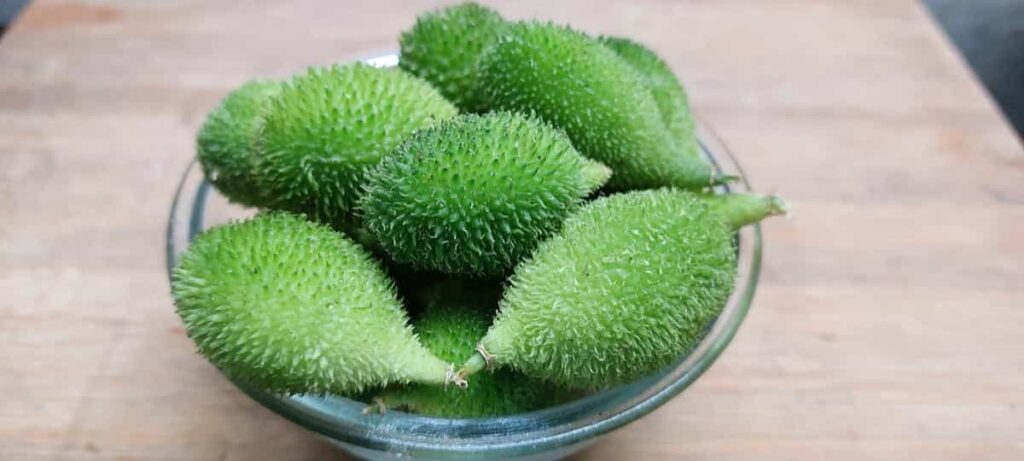
Why is spine gourd costly?
The high cost is because this produce is only accessible at certain times of the year, in contrast to most other vegetables. Because of its delicious flavor and very high nutritional content, it is enjoyed equally by vegans and non-vegetarians alike.
What conditions are favorable for growing spine gourd?
Spine gourd requires favorable circumstances for growth; although it can be grown with little effort, it’s still important to know where and when to plant it, so you obtain good harvests and how to protect your crop from pests. When planting spine gourd in the tropics, January and February are optimal for a summer crop. In addition, the monsoon crop is often planted in July. The spine gourd thrives in many soil types but does especially well in sandy to loamy soil.
It is important to have soil that has adequate drainage and is rich in organic nutrients. Soil that drains well yet retains a reasonable amount of moisture is ideal. Spine guards flourish on the ground between 5.5 and 7.0 pH. Spine gourd needs warm climes and sunny conditions to grow, although these plants may adapt to almost any environment. When grown in full sunlight, these plants thrive.
Spine guards thrive between 27 and 33 degrees Celsius, making summer the best time for their development. This farming has to be shielded from the cold of winter and the icy grip of frost. Spine gourds can be grown from tubers or seeds, with the latter being the more common method. Always use high-quality seeds and only buy from reputable retailers to avoid starting over later. To prevent the spread of fungal infections, it is important to treat seeds before planting.
In case you missed it: Spine Gourd Farming (Kakrol/Kantola) Guide
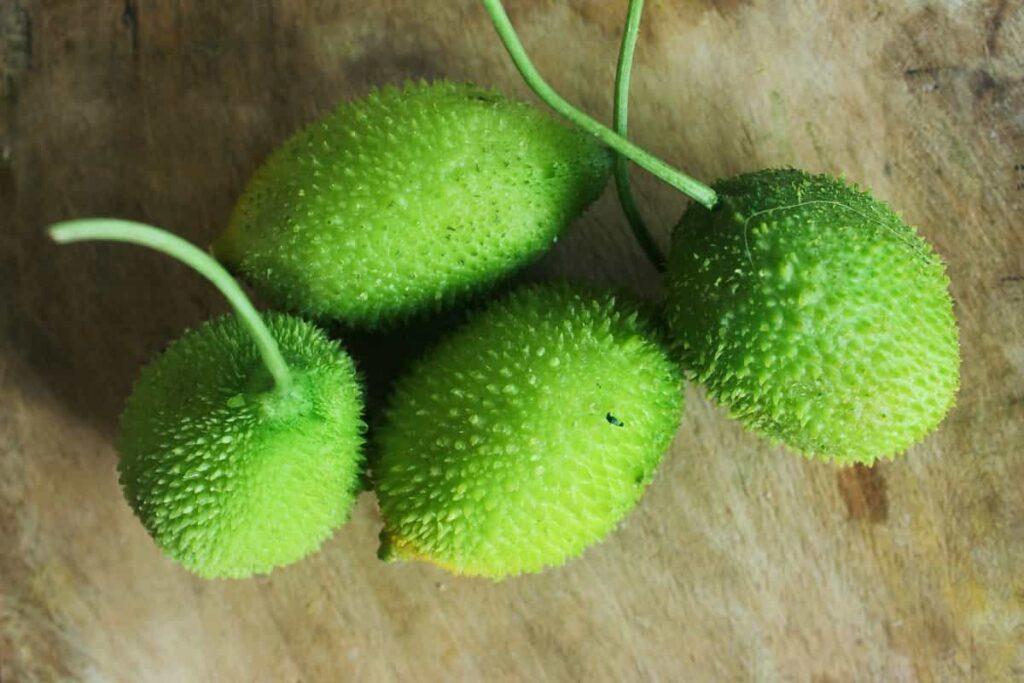
What types of Spine Gourds are available?
There are two sizes of spine gourd available on the market: small and large. Both of these sizes may be purchased. Take precautions to ensure that they do not belong to a different species. They have a similar physical appearance but vary in terms of size. In most cases, there is a greater demand for the smaller Spine gourd size than the larger one. If you want to establish a spine gourd farming business that will be successful for you, then it is advised that you start with a small-scale Spine gourd farming business.
How to take care of spine gourd plants?
The Spine gourd plant needs plenty of areas to flourish. Plants should be spaced at least 30–32 inches apart and rows at least 2 meters apart. Apply water right after planting. After that, irrigate as necessary here to local conditions. There is no need to water during a rainy season since the earth already has all it needs. Don’t get water near the plant; instead, water it once or twice weekly, depending on how wet or dry it is.
Good organic fertilizer is essential for spine gourds. When ready for your garden or farm, thoroughly add organic compost into the soil. Before sowing the whole dosage of its tubers and seeds, an application of NPK is recommended. Spine guards are climbing Nature Plants, and they need the appropriate support to climb. You can drive a stake into the ground or plant seeds close to your mesh fence.
What are the pests that attack spine gourd plants?
The most common types of invading insects are fruit flies and nematodes. To get rid of fruit flies, use organic pesticides, and keep nematodes at bay, including neem cake in the soil during preparation. Powdery Common diseases include powdery mildew, downy mildew, leaf spot, and mosaic. Seeds should be treated before planting, and the affected plant should be removed immediately. Get in touch with your local Agriculture Department for additional details.
How to plant spine gourd plants?
Spine guard seeds can be sown straight into your garden or farm using the appropriate sowing tools. Loosen the soil and get the plot ready to sow the Spine gourd seeds. Add the seed 2–5 inches deep into the soil. Plant a minimum of four seeds in each bed. Seeds are spread using broadcasting and the Dibbling technique. Broadcasting is a technique that is not appropriate for usage since the seeds are not dispersed in an equal manner when it is employed.
In case you missed it: Greenhouse Farming in the Philippines: How to Start, Agriculture Crops, and Cost to Build
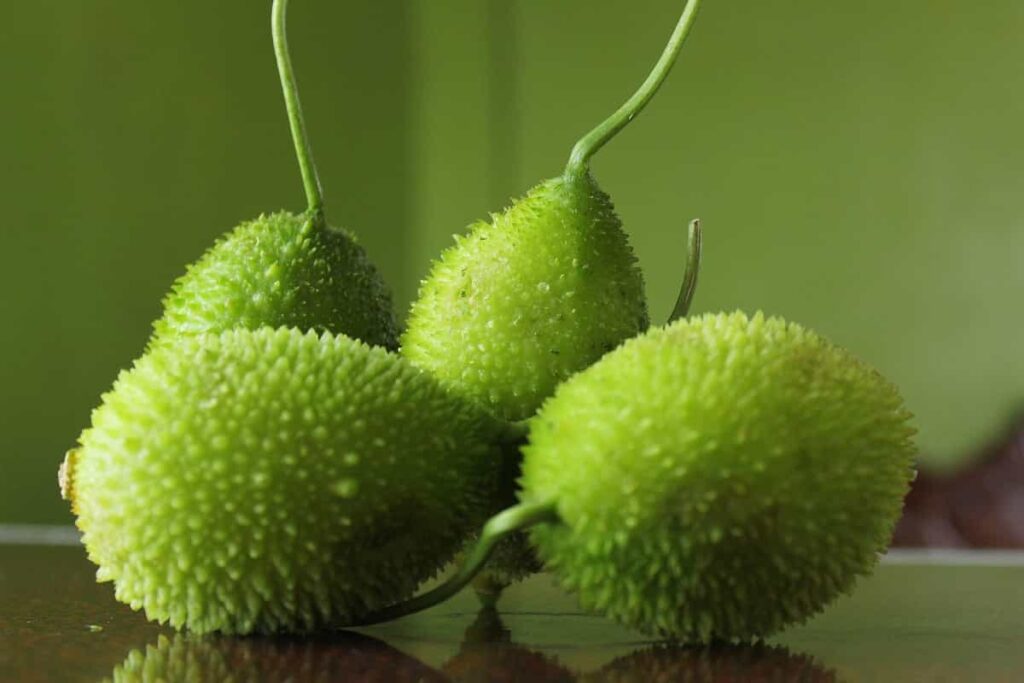
There will be a loss of seeds because of this. Dibbling is a technique utilized in circumstances where there is an adequate supply of seeds. In sowing, there is just a little adjustment made. In this case, it’s a character known as Dibbler. Plants from a nursery are also suitable for implantation. To do this, dig a hole at the desired depth and width and backfill it with compost and soil after planting the tree or shrub. The soil has to be lightly watered after planting.
How long does spine gourd cultivation last?
If Spine gourd seeds are planted in the ground, tubers will begin to grow yearly as soon as the monsoon season begins. In most cases, you can keep using the same set of tubers or plants for five or six years and still have a fair green output. However, with proper farm management and timely harvesting, 75-100 quintals per hectare of spine gourd yield are readily attainable.
Growers love this crop because of its high nutritional content and long storage life. Once planted in the ground, Spine gourd seeds will produce new tubers every year just before the monsoon season begins. You can harvest an excellent green supply from the same tubers or plants every year for up to five or six years. Spine gourd is another low-maintenance crop that can be grown easily.
Earning 8 lakh rupees from spine gourd cultivation
The Success story of Mr. Ramulu
Mr. Ramulu of Nalgonda district, Telangana, owns 5 acres of land, which he used to cultivate cotton plants. Due to unfavorable market price conditions, he didn’t get enough profits. There were also times when he faced losses due to heavy rains. He wanted to cultivate something different to make his financial situation stable. He thought of growing vegetable crops that have short growth periods.
And also, after the pandemic, he observed that specific vegetable prices have skyrocketed. He started to investigate what vegetables have high demand in the market. When he consulted the government agricultural office in his Mandal, he knew that spine gourd cultivation has much demand and this vegetable has much demand in the market. He decided to cultivate spine gourd on knowing this.
Now he wants to know how to cultivate. He visited some spine gourd farms nearby the village and learned how to cultivate them. He chose to cultivate the spine gourd on a pergola. He started his farm and is now successful in growing spine gourds and earning high profits. Below we will learn the cultivation details and investment and profit analysis of Mr. Ramulu’s farm.
In case you missed it: Earning 10 Lakh Rupees from Bamboo Cultivation: A Sucess Story of a Bamboo Farmer in India
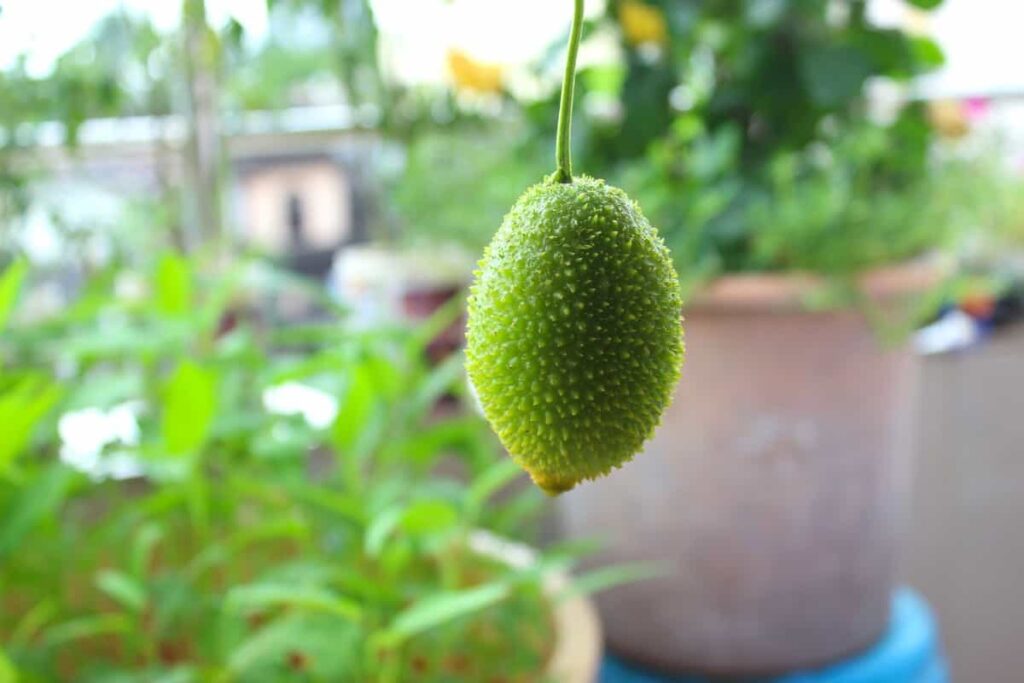
Pergola construction details, according to Mr. Ramulu
A pergola is an excellent structure for supporting climbing plants. Improvements in harvest quality, reduced the need for pesticides, and enhanced environmental conditions for fruit growth are just a few of the many benefits of this kind of farming. Traditionally, Spine gourds were grown by planting seeds directly in the ground, but this practice is now discouraged since most of the resulting plants are misshapen. The intense heat often dries off the fruit of the snake gourd.
Spine gourds can hang freely from a pergola and produce their largest and most colorful fruits. A pergola is a trellis-like structure made of poles and wires to train vines and other climbers. When the plant is fully grown, its leaves will climb up the pergola and completely cover it. The leaves of a pergola shade structure absorb sunlight at the top and screen it from reaching below, preventing the plant’s water supply from evaporating.
Mr. Ramulu built a pergola out of stone poles for his acre of land. Each pole is 8 feet in height and stands in a row. Then, he strung plastic strands between the poles to create a pergola. Each pole in a row is separated by 11 feet, for a total of 15 feet of space between rows. According to Mr. Ramulu, a pergola may continue to serve its function for up to twenty years after it has been built.
A pergola’s enormous long-term benefits outweigh its nominal, one-time cost to build. Government subsidies might reach up to half the cost of building a pergola. The agricultural office in your district or Mandal is where you should submit your application for the subsidy. He used stone poles since they were reasonably priced and would last a long time.
Spine gourd cultivation details in Mr. Ramulu’s words
Sandy and loamy red soils that absorb water are ideal for cultivating spine gourds. Spine gourd thrives in high temperatures and humidity and will grow best where there is normal rain. For land preparation, Mr. Ramulu used animal manure, chicken manure, and cow manure on his farm. After plowing, these manures should be added to the land, and once again, plowing should be done. Once this process is finished, you have to make rows and mounds in your land, says Mr. Ramulu.
Then comes the seed-sowing process; for seed-sowing, you must sow seeds very near each other. Before planting seeds, make a thin line with a stick on the rows and drop each seed near the other. If you give a 1 or 1.5 feet gap as given in other vining vegetable plants, you will see a very low germination percentage, and most of the field will be empty. Mr. Ramulu bought seeds from another spine gourd farmer at 2000 rupees per kg.
In case you missed it: How to Control Pests and Diseases in Guava: Causes, Symptoms, Chemical, and Biological Management
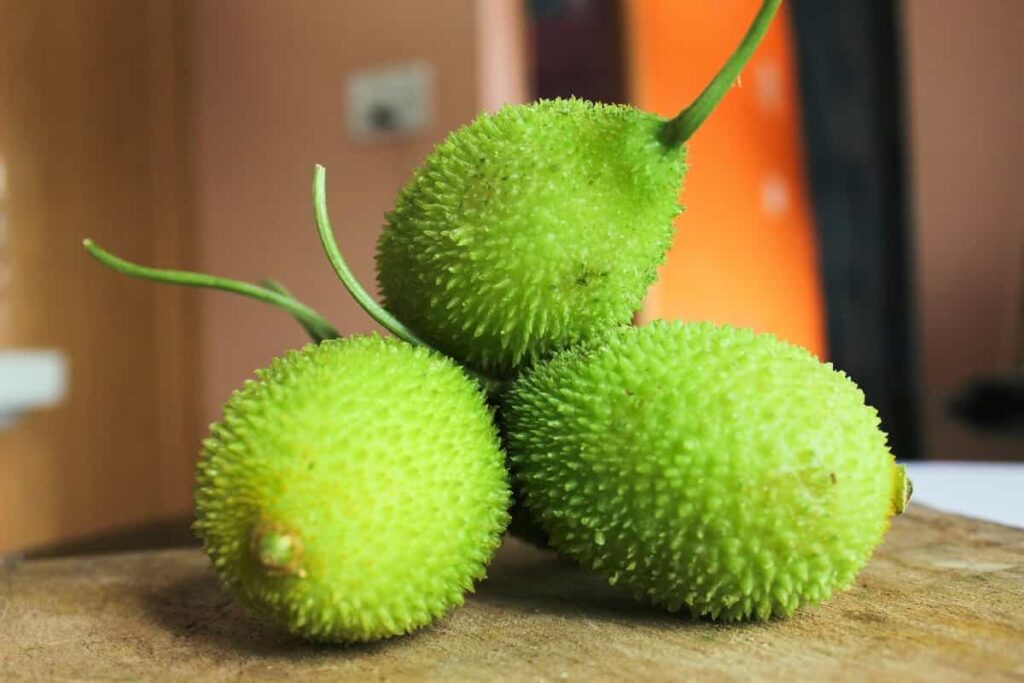
It took him nearly 5 kgs of seeds per acre. Showing 5 kg of seeds is ideal, says Mr. Ramulu; this is because even if a few seeds don’t germinate, you won’t behave any trouble. It takes nearly 15 days for the seeds to germinate. One of the most critical difficulties farmers face is distinguishing between male and female plants. Spine gourd is not self-pollinating, so you must learn to differentiate between male and female plants.
If male plants are more in number, then you won’t get any yield. So you have to ensure that one male plant is planted for every ten female plants. At the time of germination, as male flowers will germinate soon and mature soon, you have to take them off to increase the female population. This is one of the most crucial aspects, says Mr. Ramulu.
Mr. Ramulu used a drip irrigation system for watering his plants. He says this is an ideal watering process for any vining plant. For spine gourds, watering is given on alternate days once they are germinated. As the crop will be started in the late summer, if there is still high temperature, you can even water them daily, says Mr. Ramulu. Once the crops reach 3 feet tall and the vines start to grow, you have to trellis them to a pergola.
Threads hanging from the pergola should be tied to the ends of plants, which helps the vines to creep to the pergola. Once the vines reach the pergola, take off the threads. Weeds must be removed, says Mr. Ramulu. Weeds are a potential threat to the spine gourd crops. Mr. Ramulu suggests not using preventive weed chemicals. Instead, hand weeding is optimal. Weed-preventing chemicals can affect the leaves most of the time, and when used in large amounts, they can also hinder plant growth and make soil unfertile.
These crops take the same fertilizers as other vining crops. The crops are fertilized by spraying micronutrients between specific dates, beginning 20 days after the seeds are planted. They also alternate weekly between distributing 19:19:19 (4 kilos per acre) and 12:61:00 (4 kilos per acre). In addition, once a week after seed germination has begun, 1 kilogram of seaweed per acre of land is added to the plants. These help Spine gourd plants grow quickly and well. As spine gourd is a forest variety, these don’t get attacked by many pests and diseases.
Even if your crop got attacked by any pests, required insecticides should be sprayed off, says Mr. Ramulu. Mr. Ramulu harvests nearly 3 to 4 tons per acre in the whole season. The first cutting starts after 75 days of seed sowing. You can indeed harvest continuously for two years from one crop, but the yield will be low in the second year, and the fruit quality is also less. So farmers only cultivate spine gourd for one year and then rotate the crop to another vine variety, says Mr. Ramulu.
In case you missed it: Greenhouse Farming in Australia: How to Start, Cost, Crops, and Subsidy
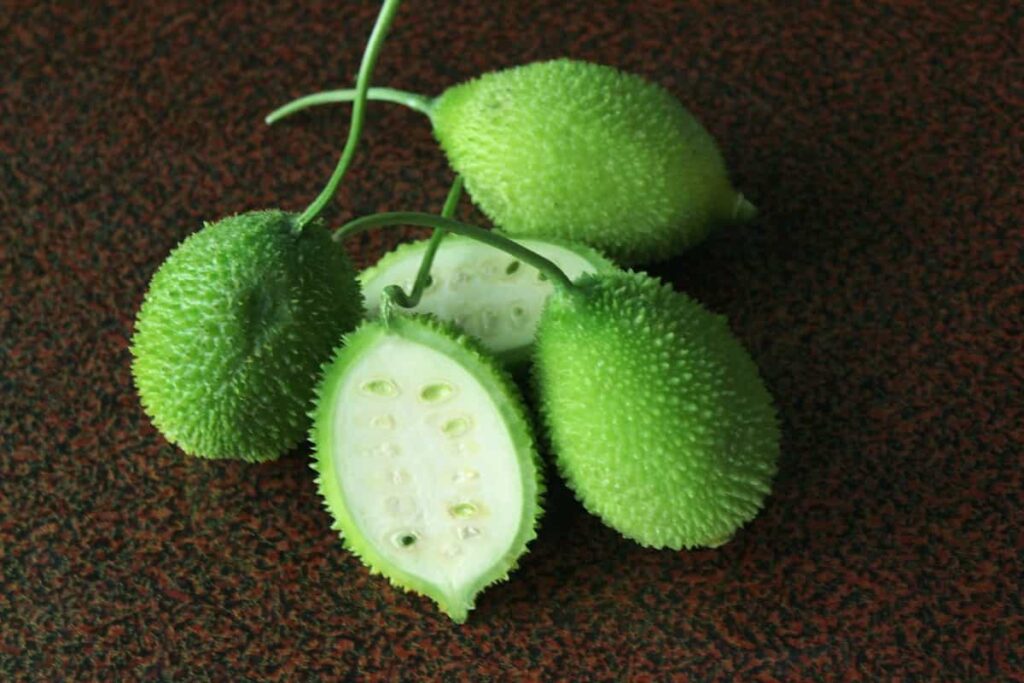
Investment and profit analysis of Mr. Ramulu’s spine gourd farm
As mentioned above, Mr. Ramulu averages nearly 3 tons per acre. He sells this harvest to the market at almost 80 rupees per kg. This means his income per acre would be about 2,40,000 rupees. His average investment per acre is nearly 80,000 rupees. Therefore, he gets nearly 1,60,000 rupees per acre when erasing investment from the income as profit, says Mr. Ramulu. When calculating this profit for his whole 5-acre farm, his net profit would be nearly 8,00,000 rupees per year.
Every farmer knows that this is a very good profit for 5-acre cultivation. Also, the above calculations are based on average figures, so if you take good care of your farm, you can easily get more profit than shown above. Mr. Ramulu is now financially stable and happy that his spine gourd farm is successful. He also guides many farmers who started spine gourd cultivation in his village.
- Economical Aquaculture: A Guide to Low-Budget Fish Farming
- 15 Common Planting Errors That Can Doom Your Fruit Trees
- How to Make Houseplants Bushy: Effective Tips and Ideas
- Innovative Strategies for Boosting Coconut Pollination and Yield
- Pollination Strategies for Maximum Pumpkin Yield
- The Complete Guide to Chicken Fattening: Strategies for Maximum Growth
- Natural Solutions for Tulip Problems: 100% Effective Remedies for Leaf and Bulb-Related Issues
- Revolutionizing Citrus Preservation: Towards a Healthier, Greener Future
- Natural Solutions for Peony Leaf and Flower Problems: 100% Effective Remedies
- Maximizing Profits with Avocado Contract Farming in India: A Comprehensive Guide
- Natural Solutions for Hydrangea Problems: 100% Effective Remedies for Leaf and Flowers
- The Ultimate Guide to Choosing the Perfect Foliage Friend: Bringing Life Indoors
- From Sunlight to Sustainability: 15 Ways to Use Solar Technology in Agriculture
- The Ultimate Guide to Dong Tao Chicken: Exploring from History to Raising
- The Eco-Friendly Makeover: How to Convert Your Unused Swimming Pool into a Fish Pond
- Mastering the Art of Delaware Chicken Farming: Essentials for Healthy Backyard Flocks
- 20 Best Homemade Fertilizers for Money Plant: DIY Recipes and Application Methods
- How to Craft a Comprehensive Free-Range Chicken Farming Business Plan
- Brighten Your Flock: Raising Easter Egger Chickens for Beauty and Bounty
- How to Optimize Your Poultry Egg Farm Business Plan with These Strategies
- Subsidy for Spirulina Cultivation: How Indian Government Schemes Encouraging Spirulina Farmers
- Ultimate Guide to Raising Dominique Chickens: Breeding, Feeding, Egg-Production, and Care
- Mastering the Art of Raising Jersey Giant Chickens: Care, Feeding, and More
- Ultimate Guide to Raising Legbar Chickens: Breeding, Farming Practices, Diet, Egg-Production
- How to Raise Welsummer Chickens: A Comprehensive Guide for Beginners
- How to Protect Indoor Plants in Winter: A Comprehensive Guide
- Ultimate Guide to Grow Bag Gardening: Tips, Tricks, and Planting Ideas for Urban Gardeners
- Guide to Lotus Cultivation: How to Propagate, Plant, Grow, Care, Cost, and Profit
- Agriculture Drone Subsidy Scheme: Government Kisan Subsidy, License, and How to Apply Online
- Ultimate Guide to Raising Araucana Chickens: Breed Profile, Farming Economics, Diet, and Care
- Bringing Hydroponics to Classroom: Importance, Benefits of Learning for School Students
- Ultimate Guide to Raising Polish Chickens: Breed Profile, Farming Economics, Diet, and Care
- Ultimate Guide to Raising Australorp Chickens: Profile, Farming Economics, Egg Production, Diet, and Care
- Silkie Chicken Farming: Raising Practices, Varieties, Egg Production, Diet, and Care
- Sussex Chicken Farming: Raising Practices, Varieties, Egg Production, Diet and Care
- Homemade Feed Formulations for Livestock: Discover Cost-effective Starter to Finisher Feed Recipes